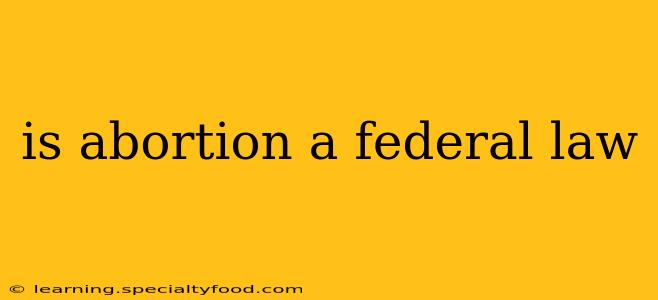Is Abortion a Federal Law? The Complex Landscape of Reproductive Rights in the United States
The question of whether abortion is a federal law is a complex one, with the answer being a resounding no, but with significant nuances. There's no single federal law that dictates the legality of abortion across the entire United States. Instead, the legal status of abortion is a patchwork of federal and state regulations, shaped by decades of legal battles and evolving social views.
Historically, abortion laws were largely determined at the state level. However, the landmark Supreme Court case Roe v. Wade (1973) significantly altered the landscape. This ruling established a woman's constitutional right to an abortion, based on the right to privacy under the Fourteenth Amendment. Roe v. Wade didn't create a federal law mandating abortion access, but it did impose limitations on states' abilities to restrict abortion.
This federal protection, however, was significantly weakened, and ultimately overturned, by the Supreme Court's decision in Dobbs v. Jackson Women's Health Organization (2022). This ruling effectively returned the authority to regulate abortion to individual states, leading to a wide variation in access to abortion care across the country.
What are the key federal laws related to abortion?
While there isn't a federal law directly legalizing or prohibiting abortion nationwide, several federal laws indirectly affect access to abortion care. These include:
-
The Hyde Amendment: This rider attached to annual appropriations bills prohibits the use of federal funds to pay for abortions, except in cases of rape, incest, or when the mother's life is at risk. This significantly impacts access to abortion for low-income women who rely on government assistance.
-
The Affordable Care Act (ACA): While the ACA doesn't directly fund abortions, it requires most health insurance plans to cover preventive services, including some reproductive health services. However, the specifics of what is covered can vary based on individual plan provisions and the Hyde Amendment restrictions.
-
The Women's Health Protection Act (WHPA): This proposed legislation aimed to codify the protections established in Roe v. Wade, ensuring access to abortion nationwide. Despite passing the House of Representatives, it failed to gain enough support in the Senate and did not become law.
What happened after Roe v. Wade was overturned?
The overturning of Roe v. Wade in Dobbs v. Jackson Women's Health Organization has resulted in a dramatic shift in the legal landscape of abortion in the United States. Now, states have the power to enact their own laws regarding abortion access, ranging from near-total bans to maintaining relatively liberal access. This has created significant disparities in access to abortion based on geographic location.
How does the federal government still impact abortion access?
Even without a federal law directly addressing abortion, the federal government continues to play a role in influencing access. This influence is exerted through:
-
Funding: Federal funding restrictions, such as the Hyde Amendment, continue to impact the availability of abortion services, particularly for low-income women.
-
Medicaid: The federal government plays a significant role in funding state Medicaid programs, and decisions about whether to use those funds for abortion services are made at the state level.
-
Data Collection and Research: Federal agencies collect data on abortion rates and related statistics, which can inform public health initiatives and policy discussions.
What's the future of abortion access in the United States?
The future of abortion access in the US remains uncertain and heavily dependent on state-level legislation and ongoing legal challenges. The overturning of Roe v. Wade has fueled a national debate, prompting both legal battles and political activism on both sides of the issue. The Supreme Court's decision has undeniably created a significant shift in the legal and political landscape, and the long-term consequences are yet to be fully realized.
In conclusion, while there is no federal law directly addressing abortion nationwide, the federal government plays a significant indirect role through funding, regulations, and the impact of Supreme Court decisions. The legality and access to abortion in the United States are now primarily determined at the state level, leading to a complex and often uneven landscape of reproductive rights.
